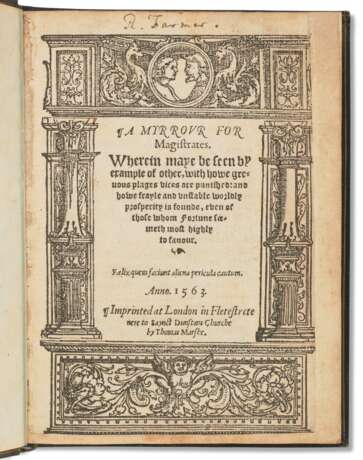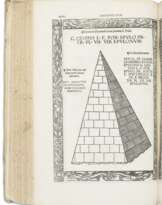ID 627617
Lot 128 | A Myrrour for Magistrates
Estimate value
$ 5 000 – 8 000
The Cole-Terry-Hogan copy of an important Shakespeare source. Second edition, first issue, of this influential collection of Tudor poetry. In this collaborative work, the ghosts of eminent rulers recount their downfalls as exempla to readers. After a planned edition of 1554 had been suppressed by the Lord Chancellor, the first edition appeared in 1559. Baldwin, in his preface to the first edition, writes that the whole design had been suggested by George Ferrers on the model of Lydgate's The Fall of Princes. This expanded second edition contains eight additional legends and the "Induction" by Thomas Sackville, including the tragedy of the Duke of Somerset by Ferrers, which had been omitted from the first edition. The story of Queen Cordilla partially inspired Shakespeare's King Lear. This copy with the first setting of Aa1r. Grolier Langland to Wither 174; Pforzheimer 731; ESTC S100551.
Quarto (182 x 133mm). Title with woodcut architectural border [McKerrow and Ferguson 38], woodcut initials (title page window-mounted, small repairs to blank corners and margins occasionally touching letters, some staining and soiling, a few wormholes in text at end, partially perforated library stamp on first text leaf). 19th-century navy straight-grained morocco gilt, edges gilt (slight wear); custom slipcase. Provenance: "Dr. R. Farmer" (signature title page) – John William Cole (bookplate, sold Wheatley's Galleries in 1837 to:) – W. H. Miller (old description) – S. R. Christie-Miller of Britwell Court Library (old description) – Seth Terry (morocco book label, his sale, 1935) – Frank J. Hogan (1877-1944, American lawyer; morocco bookplate; his sale, 1945).
| Artist: | William Shakespeare (1564 - 1616) |
|---|---|
| Applied technique: | Pencil |
| Artist: | William Shakespeare (1564 - 1616) |
|---|---|
| Applied technique: | Pencil |
| Address of auction |
CHRISTIE'S 8 King Street, St. James's SW1Y 6QT London United Kingdom | |
|---|---|---|
| Preview |
| |
| Phone | +44 (0)20 7839 9060 | |
| Buyer Premium | see on Website | |
| Conditions of purchase | Conditions of purchase |














